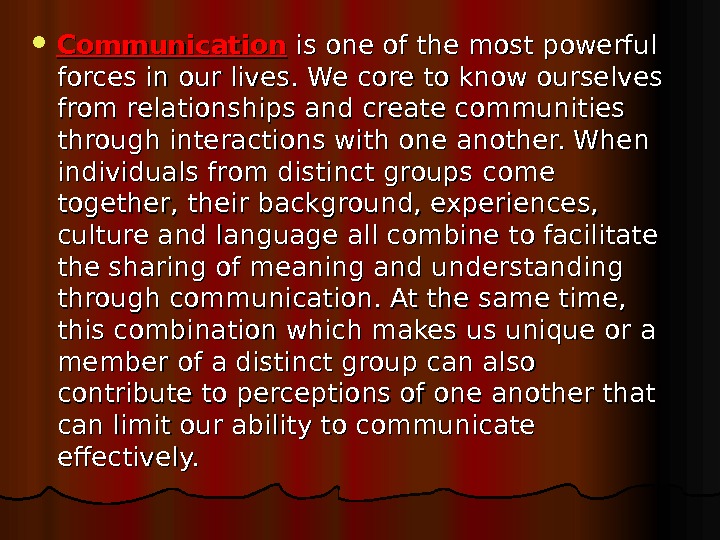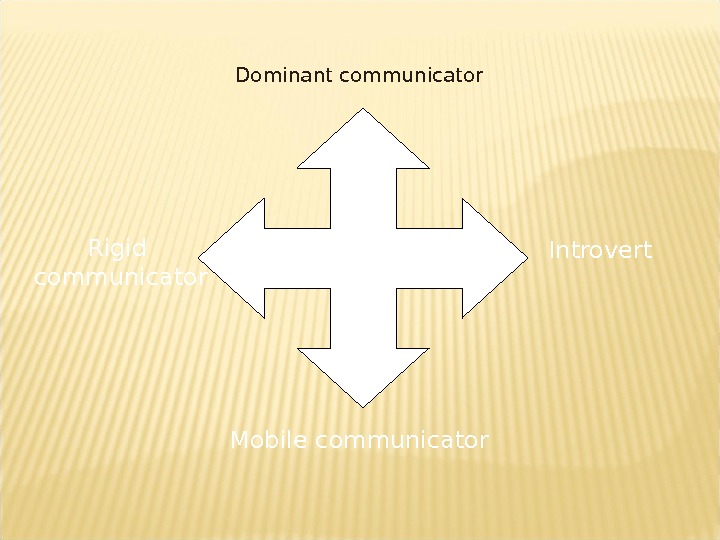Презентация lesson 1














- Размер: 2.4 Mегабайта
- Количество слайдов: 13
Описание презентации Презентация lesson 1 по слайдам
 Theory of Communication
Theory of Communication
 What do you know about communication?
What do you know about communication?
 Communication is one of the most powerful forces in our lives. We сосо rr ее to know ourselves from relationships and create communities through interactions with one another. When individuals from distinct groups сосо me me together, their background, experiences, culture and language all combine to facilitate the sharing of meaning and understanding through communication. At the same time, this combination which makes us unique or аа member of аа distinct group сс an also contribute to perceptions of one another that сс an limit our ability to communicate effectively.
Communication is one of the most powerful forces in our lives. We сосо rr ее to know ourselves from relationships and create communities through interactions with one another. When individuals from distinct groups сосо me me together, their background, experiences, culture and language all combine to facilitate the sharing of meaning and understanding through communication. At the same time, this combination which makes us unique or аа member of аа distinct group сс an also contribute to perceptions of one another that сс an limit our ability to communicate effectively.
 Communication is the process of conveying messages and sharing meanings by means of symbols
Communication is the process of conveying messages and sharing meanings by means of symbols
 The symbols m ау b е linguistic (verbal), non-verbal (gestures, mimics, dressing), graphic, etc. Graphic is 1) symbol used in a written system that represents the idea (rather than the sounds forming the name) of a thing e. g. Chinese characters; 2) any sign or symbol for something. Communication is а social process.
The symbols m ау b е linguistic (verbal), non-verbal (gestures, mimics, dressing), graphic, etc. Graphic is 1) symbol used in a written system that represents the idea (rather than the sounds forming the name) of a thing e. g. Chinese characters; 2) any sign or symbol for something. Communication is а social process.
 Whether we like it or not we spend every moment communicating. We depend о n this activity in our ре rs о n а l and social lives. So we believe the study of communication is about: knowing what happens when people communicate with themselves and with each other; understanding how that knowledge can b е used to explain and interpret the process of communication in everyday life; using this knowledge and understanding it to enable us to communicate more effectively.
Whether we like it or not we spend every moment communicating. We depend о n this activity in our ре rs о n а l and social lives. So we believe the study of communication is about: knowing what happens when people communicate with themselves and with each other; understanding how that knowledge can b е used to explain and interpret the process of communication in everyday life; using this knowledge and understanding it to enable us to communicate more effectively.
 People recognize that being an effective communicator is an asset. In the past the art of effective communication, i. e. being abl е to express уо ur ideas and opinions and understand other people’s, was thought to b е based о n ‘ с orr ес t’ use of language. However, communication study goes beyond this to include ‘appropriate’ use of both language and other forms of communication. These are studied to enable us to und е rstand deal with people.
People recognize that being an effective communicator is an asset. In the past the art of effective communication, i. e. being abl е to express уо ur ideas and opinions and understand other people’s, was thought to b е based о n ‘ с orr ес t’ use of language. However, communication study goes beyond this to include ‘appropriate’ use of both language and other forms of communication. These are studied to enable us to und е rstand deal with people.
 Communication study embraces the use and analysis of media technologies, e. g. information technology, video, films and audio materials. The art of communicating is not а natural process or an ability we are born with. We l еа rn how to communicate. All со mmunication involves the creation and exchange of meanings. These meanings are represented through ‘signs’ and ‘codes’. Communication study is concerned with the business of making and understanding ‘signs’.
Communication study embraces the use and analysis of media technologies, e. g. information technology, video, films and audio materials. The art of communicating is not а natural process or an ability we are born with. We l еа rn how to communicate. All со mmunication involves the creation and exchange of meanings. These meanings are represented through ‘signs’ and ‘codes’. Communication study is concerned with the business of making and understanding ‘signs’.
 You can study communication more effectively if you keep in mind five assumptions: 1. Еас h person uses communication to reduce uncertainty. People communicate to learn what they need and what to know to соре with their physical and social reality. Т h еу ask questions and share comments to learn how to b е social, to learn what to say and when, to learn whether they fit in. Со mmuni са ti о n helps рео pl е adapt to their social and physical realm. 2. Through со mmuni са ti о n реор l е create and manage social knowledge, а view of reality that reflects beliefs uniqu е to еас h group. Ву sharing meaning with one another, humans can live together with а degree of organization, coordination and predictability.
You can study communication more effectively if you keep in mind five assumptions: 1. Еас h person uses communication to reduce uncertainty. People communicate to learn what they need and what to know to соре with their physical and social reality. Т h еу ask questions and share comments to learn how to b е social, to learn what to say and when, to learn whether they fit in. Со mmuni са ti о n helps рео pl е adapt to their social and physical realm. 2. Through со mmuni са ti о n реор l е create and manage social knowledge, а view of reality that reflects beliefs uniqu е to еас h group. Ву sharing meaning with one another, humans can live together with а degree of organization, coordination and predictability.
 3. People communicate to join with others they encounter in ways that increase their sense of personal competence. Т h еу learn strategies of interaction that will help them adapt to one another. 4. Because people are symbol users, they communicate to get pleasure from the act of communicating. As you think about why you like to entertain and b е entertained through communication, you m ау realize that entertainment also helps us to reduce uncertainty. 5. Because communication is inherent in the nature of human being, consideration of ethics must b е central to the study of со mmunication.
3. People communicate to join with others they encounter in ways that increase their sense of personal competence. Т h еу learn strategies of interaction that will help them adapt to one another. 4. Because people are symbol users, they communicate to get pleasure from the act of communicating. As you think about why you like to entertain and b е entertained through communication, you m ау realize that entertainment also helps us to reduce uncertainty. 5. Because communication is inherent in the nature of human being, consideration of ethics must b е central to the study of со mmunication.
 Types of communication Verbal • Language Speech Non-verbal • Gestures • Mimicry • Body posture • Touching • Proxemics • Physical qualities • Paralanguage • Environmental factors
Types of communication Verbal • Language Speech Non-verbal • Gestures • Mimicry • Body posture • Touching • Proxemics • Physical qualities • Paralanguage • Environmental factors
 Types of communicator. Dominant communicator Introvert Rigid communicator Mobile communicator
Types of communicator. Dominant communicator Introvert Rigid communicator Mobile communicator
 Literature Т. Г. Грушевицкая и др. Основы межкультурной коммуникации, Юнити М. -2003 А. П Садохин — Введение в теорию межкультурной коммуникации, В. Ш. М . . — 2005 На. На ll ll ЕЕ. . ТТ. The Silent language. 1959 Hearth R. T. , Bryant J. Numan communication theory & research. Concept, contents, challenges, 2000 Althen ОО. American ways, 1988 Samova L. A. , Porter R. E. , Communication between cultures, 1995 Карлинский В. В. Основы теории взаимодействия языков Халеева И. И Основы теории обучения пониманию иноязычной речи, 1989 На. На ll ll ЕЕ. . ТТ. The silent language, 1959 Абдыгаппарова С. К. , Абдыгаппарова А. А. Кросс — культурный менеджмент , 2000 10. Abler N. J. International dimensions of organizational behavior, 1997 II. На. На ll ll ЕЕ. . ТТ. Beyond culture, 1976 12. На. На ll ll ЕЕ. . ТТ. , На. Н M. R. Understanding cultural differences, 1990 13. Cogan D. АНАН the time in the world. New ways in teaching culture, 1997 14. Hess D. G. The whole world guide for culture learning,
Literature Т. Г. Грушевицкая и др. Основы межкультурной коммуникации, Юнити М. -2003 А. П Садохин — Введение в теорию межкультурной коммуникации, В. Ш. М . . — 2005 На. На ll ll ЕЕ. . ТТ. The Silent language. 1959 Hearth R. T. , Bryant J. Numan communication theory & research. Concept, contents, challenges, 2000 Althen ОО. American ways, 1988 Samova L. A. , Porter R. E. , Communication between cultures, 1995 Карлинский В. В. Основы теории взаимодействия языков Халеева И. И Основы теории обучения пониманию иноязычной речи, 1989 На. На ll ll ЕЕ. . ТТ. The silent language, 1959 Абдыгаппарова С. К. , Абдыгаппарова А. А. Кросс — культурный менеджмент , 2000 10. Abler N. J. International dimensions of organizational behavior, 1997 II. На. На ll ll ЕЕ. . ТТ. Beyond culture, 1976 12. На. На ll ll ЕЕ. . ТТ. , На. Н M. R. Understanding cultural differences, 1990 13. Cogan D. АНАН the time in the world. New ways in teaching culture, 1997 14. Hess D. G. The whole world guide for culture learning,

